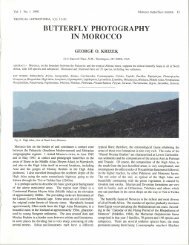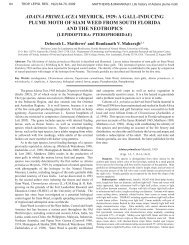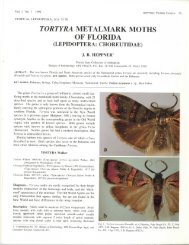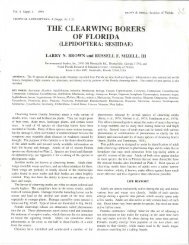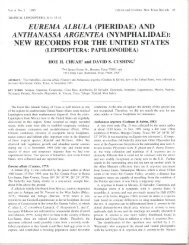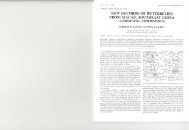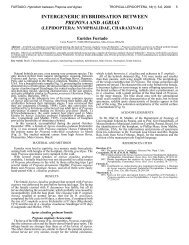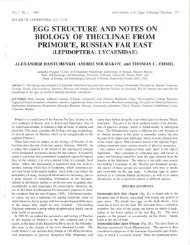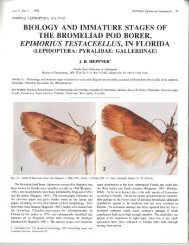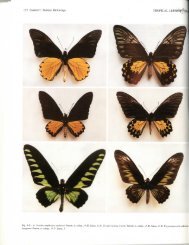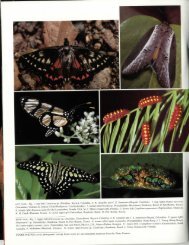natural history, immature stages and hostplants of morpho ...
natural history, immature stages and hostplants of morpho ...
natural history, immature stages and hostplants of morpho ...
You also want an ePaper? Increase the reach of your titles
YUMPU automatically turns print PDFs into web optimized ePapers that Google loves.
Vol. 8 No. 2 1997 CONSTANTINO: Morpho amathonte Biology 79Morpho possess at least two secretory gl<strong>and</strong>s: the cervical gl<strong>and</strong>,located anterior to the first set <strong>of</strong> legs, extruded when a caterpillaris molested <strong>and</strong> which emits a strong odor, <strong>and</strong> the groominggl<strong>and</strong>, located between the subdorsal tufts on segment A-l, whichsecretes a liquid that is groomed into the subdorsal tufts <strong>of</strong> setae.Both secretory gl<strong>and</strong>s are likely to serve a defensive function(DeVries <strong>and</strong> Martinez, 1993). A new gl<strong>and</strong>, termed here as theepicranial gl<strong>and</strong> which has apparently never been describedpreviously, secretes a drop <strong>of</strong> a clear oily fluid from a dorsal porelocated on the epicranium (Fig. 3) which is then combed into thevarious tufts <strong>of</strong> setae along the body. The larvae is able to retainthe drop <strong>of</strong> the fluid on a groove located on the epicranium. Thegroove is bifurcated at the end in two sclerotized sharp spikesprojected backwards. These spikes or small horns are used tocomb the oily fluid into the subdorsal abdominal tufts <strong>of</strong> setae.Usually, the spikes are difficult to see in live larvae because theyare concealed by the setae on the head capsule, but can be seeneasily under the microscope in the head capsules <strong>of</strong> all instarsthat have been preserved in alcohol. When larvae are molested,they lift the head backwards, <strong>and</strong> the drop <strong>of</strong> liquid is combedinto the subdorsal setae on T-l <strong>and</strong> T-2. Then with a slow,rotating motion <strong>of</strong> the head, the drop is combed into all abdominalsubdorsal tufts <strong>and</strong> setae. This oily substance acts as an insectrepellent against parasitic wasps <strong>and</strong> ants, in addition to being awater repellent. The epicranial gl<strong>and</strong> <strong>and</strong> sclerotized spikesprojected backwards have been observed also in two other species<strong>of</strong> Morpho caterpillars in Colombia: M. sulkowskyi <strong>and</strong> M,patroclus (M. D. Heredia, in prep.; L. M. Constantino, pers.observ.)Life cycleThe complete life cycle <strong>of</strong> M. amathonte requires about 120days (4 months) from egg to adult, with the egg lasting 14 days,the larvae about 83 days, the prepupal stage 4 days, <strong>and</strong> the pupa19 days.HostsCespedesia macrophylla <strong>and</strong> C. spathulata (Ochnaceae), inwestern Colombia.ACKNOWLEDGMENTSAll photographs in this paper were taken by GermSn Ramirez <strong>and</strong>Guillermo Guzman (CIAT, Palmira) from life <strong>history</strong> <strong>stages</strong> reared bythe author in Colombia. I wish to thank also butterfly farmers Juan deDios Ramos (COAGRITA, Tatabro), Justine Angulo <strong>and</strong> Te<strong>of</strong>iloCamacho (Tatabro), for assistance in caring for the early <strong>stages</strong> <strong>and</strong> forfield work. A special thanks to Jacob Ol<strong>and</strong>er (Ecuador), Juan C.Riascos, Andres Alarc6n, Emilio Constantino (Fundaci6n HerenciaVerde, Cali), Fern<strong>and</strong>o Cast (Proyecto Biopacifico), <strong>and</strong> Ma. DoloresHeredia (Cali) for advice. Thanks also to Luiz S. Otero (Brazil) forproviding some important references <strong>and</strong> hostplant records <strong>of</strong> Morphospecies. This series <strong>of</strong> butterfly life <strong>history</strong> studies is part <strong>of</strong> the projecton butterfly farming by the Anchicaya River, supported by FundacionHerencia Verde (FHV) <strong>and</strong> Proyecto Biopacifico (PBP), Ministerio delMedio Ambiente, PNUD-GEF-Col/92/G31.LITERATURE CITEDAckery, P. R.1988. Host plants <strong>and</strong> classification: a review <strong>of</strong> nymphalid butterflies.Biol. J. Linn. Soc. (London), 33:95-203.Barcant, M.1970. Butterflies <strong>of</strong> Trinidad <strong>and</strong> Tobago. London: Collins. 350pp.Constantino, L.M.1992. Paradulcedo, a new genus <strong>of</strong> Satyrinae (Nymphalidae) fromwestern Colombia. J. Lepid. Soc. (Los Angeles), 46:44-53.1993. Notes on Haetera from Colombia, with descriptions <strong>of</strong> the<strong>immature</strong> <strong>stages</strong> <strong>of</strong> Haetera piera (Nymphalidae: Satyrinae).Trap. Lepid. (Gainesville), 4:13-15.1995. Revision de la tribu Haeterini Herrich-Schaffer, 1864 enColombia (Nymphalidae, Satyrinae). SHILAP Revta. Lepid.(Madrid), 23:49-76.[in press]. Butterfly life <strong>history</strong> studies, diversity, ranching <strong>and</strong>conservation in the Choc6 rain forests <strong>of</strong> western Colombia.SHILAP Revta. Lepid.(Madrid).D'Abrera, B.1984. Butterflies <strong>of</strong> the Neotropical Region, Part II. Danaidae,Ithomiidae, Heliconidae & Morphidae. Hill House, Victoria.232pp.d'Aranjo e Silva, A. G., C. R. Conceives, D. M. Galvao, A. J. L.Conceives, J. Gomes, M. N. Silva, <strong>and</strong> L. Simoni1968. Quarto catalogo dos insectos que vivem nas plantas do Brasil;seus parasitas e predadores. Rio de Janeiro: Minist. Agric.265pp.DeVries, P. J.1987. The Butterflies <strong>of</strong> Costa Rica <strong>and</strong> their Natural History. [I]:Papilionidae, Pieridae, Nymphalidae. Princeton: PrincetonUniv Press. 327pp.DeVries, P. J., <strong>and</strong> G. E. Martinez1993. The <strong>morpho</strong>logy, <strong>natural</strong> <strong>history</strong>, <strong>and</strong> behavior <strong>of</strong> the early<strong>stages</strong> <strong>of</strong> Morpho cypris (Nymphalidae: Morphinae) - 140years after formal recognition <strong>of</strong> the butterfly. J. New York.Ent. Soc., 101:515-530.Gentry, A.1993. A Field Guide to the Families <strong>and</strong> Genera <strong>of</strong> Woody Plants <strong>of</strong>Northwest South America. Washington: Conservation Intl. 895pp.Kruger, E.1924-25. Die Morphiden Columbiens nebst e inigen allgemeinenBemerkungen iiber Morphiden. Dtsch. Ent. Zeit. Iris (Dresden),38:23-39, 99-132, 223-268.LeMoult, E., <strong>and</strong> P. Real1963. Les Morpho d'Amerique du Sud et Centrale. Tome II. Paris:Edit. Le Moult. 296pp.Otero, L. S.1966. Biologic de sept Lepidopteres Bresiliens du genre MorphoFabricius, 1807. Ph.D. thesis, University <strong>of</strong> Paris. 306pp.1971. Instrucoes para criacao da borboleta "Capitao-do-mato"Morpho achillaena e outras especies do genera Morpho ("azulseda,""azulao-branco," "prain gr<strong>and</strong>i"). Rio de Janeiro: Inst.Brasil. Desenvolv. Florestal. 27pp.Rodriguez, M.1993. Contribuci6n al conocimiento de las mariposas del generoMorpho (Nymphalidae: Morphinae) de Colombia. BSc. thesis,Univ. Nac., Bogota. 250pp.Salazar, J. A.1992. Contribuci6n al conocimiento de los Morphinae Colombianos.Localizaci6n de una poblacion de Morpho rhodopteron



